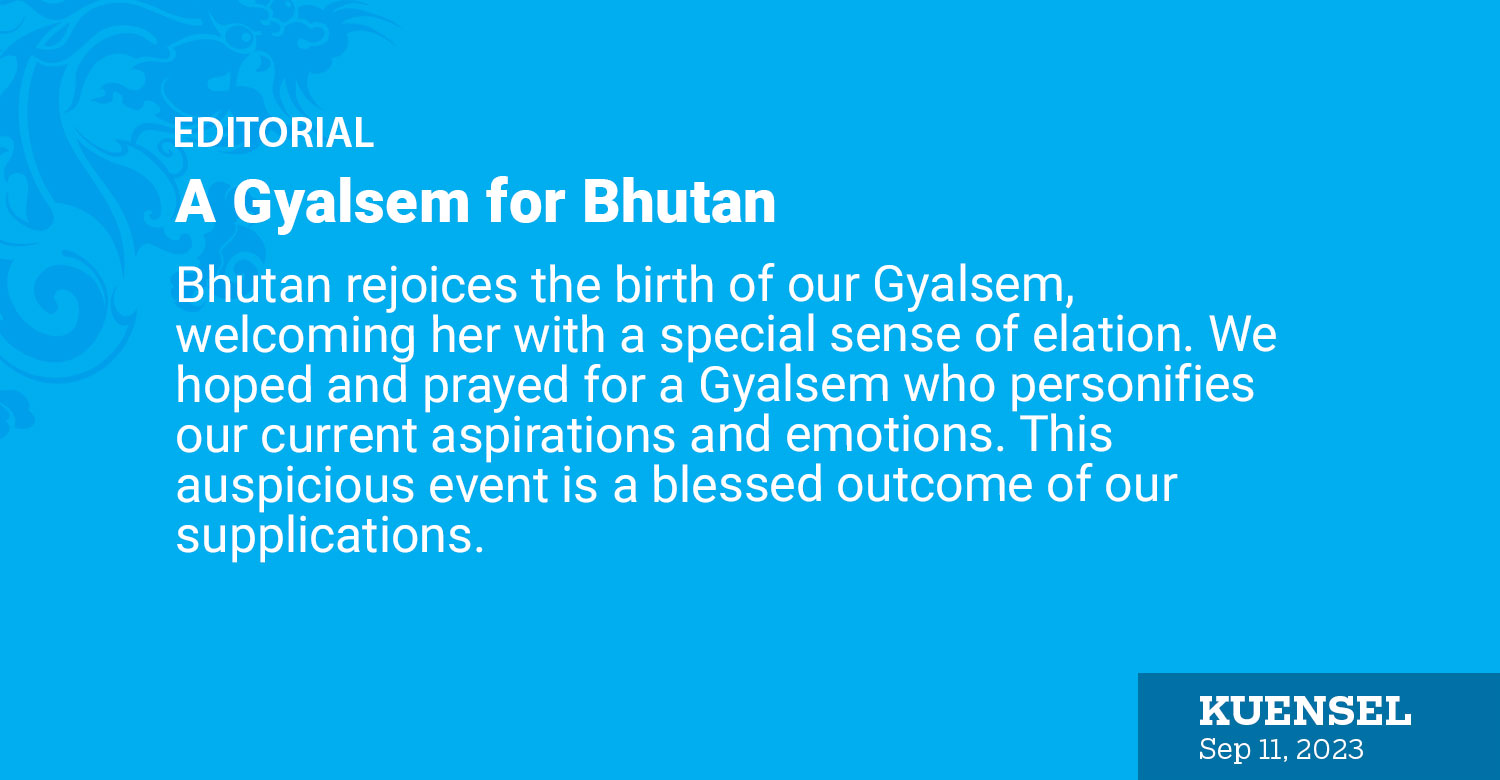Bhutan rejoices the birth of our Gyalsem, welcoming her with a special sense of elation. We hoped and prayed for a Gyalsem who personifies our current aspirations and emotions. This auspicious event is a blessed outcome of our supplications.
His Holiness the Je Khenpo said that Royal Princesses make important contributions both in terms of dharma and worldly affairs. The Gyalsem is born at a time when Bhutan is busy with activities of profound spiritual significance to overcome the global Covid crisis. We have been building and renovating dzongs and religious institutions and making offerings to the spiritual guardians of the nation – Yidam (Deities), Khandro (Dakinis), and Chhoechongs (Dharma protectors).
For our spiritual advisors, a Princess is a khandrum – manifestation of a dakini. For the older generation of Bhutanese, she symbolises a comforting balance of gender and completeness in the Royal household. And for today’s globalised young Bhutanese, there is also the magic, glamour, and romance of the Princesses of folk tales.
Our beliefs are drawn from the depths of Bhutanese culture. Bhutanese people – young and old, traditional and modern, spiritual and secular – are unanimous in the convictions that the birth of our Gyalsem is good tendrel. The science of tendrel, we have learnt, is not just fortune or providence; it does not just happen. It is the culmination of merit that we earn through our aspirations, devotion, and prayers. Beyond dreams and fairy tales, our beliefs stem from real life – our spiritual, social, and cultural experiences, and our history.
Her Royal Highness the Gyalsem belongs to the sixth generation of the Wangchuck lineage, a dynasty which built and stabilised our Kingdom. The Royal women of the lineage transcended the concept of gender inequities in society. Royal women, through the generations, were not just gracious hostesses for courtly events. As adults, they personified an aura of peace, being a calming influence in the Royal court, sometimes clarifying submissions and actions of people to the Monarch.
The story of Bhutanese women, even as we know it, evolves from Guru Rinpoche to the Wangchuck dynasty and will continue into the future. Even as they navigated the complexities of court life, Queens and Princesses earned their space in Bhutanese history with dignity and respect. As patrons of Bhutan’s spiritual heritage, they built institutions and supported practitioners throughout the kingdom. They shaped the cultural, social, and environmental landscape, and often helped ensure political stability.
Bhutanese history is enriched by the likes of Princess Jitsuen Dem who taught the known world that you can achieve spiritual enlightenment as a female. Guru Rinpoche’s consort, Moenmo Tashi Khyildon, was his companion during his meditation in Taktshang. Jigme Namgye’s yum, Pem Choki, was known to be an influence in his statecraft. His Majesty Ugyen Wangchuck’s sister, Ashi Wangmo, composed songs of such meaning and melody that listeners were reduced to tears.
In the era of modernisation and change, Bhutan’s Royal women still transcend the concept of gender. Their place and role in the life of the nation does not, and will not, change. But it will evolve with the times.
We remember Yum Phuntsho Choden, with an aura of mythological proportions, patron of country-wide spiritual instititions, and a benign grandmother who personified family values. Yum Kesang Choden is a Royal matriarch and patron of our spiritual heritage with a balance of dignity and grace that makes her a fountain of dignity for her immediate as well as extended family.
Today, Their Majesties the Gyalyums and Their Royal Highnesses are active patrons of our spiritual heritage and culture as well as of GNH, youth, women, rural development, civil society, and the environment.
Her Majesty Gyaltsuen Jetsun Pema is a passionate patron of the environment, supporter of rural communities, and concerned about the wellbeing of people with a focus in recent times on mental health which is emerging as a debilitating health problem.
Her Royal Highness the Gyalsem comes into a society which is in vibrant debate on female leadership in a new age. Given the rapid transformation of the nation, our Gyalsem will grow in a future that the current generation may not even comprehend.
The science of academia teaches that a personality is shaped by the environment of our upbringing. Eastern wisdom has always maintained that a person’s character is determined by the circumstances of birth. Gyalsem is born in the female Year of the Rabbit, defined as a person who is known to be kind and elegant, quick and alert. The Bhutanese dathog emphasises that a person born in the year of the Rabbit is dependable and stable and is always loyal to those around them.
As we celebrate, we are reminded of the good tendrel on the birth of the Royal children. His Holiness the Je Khenpo said that religious institutes and organisations will conduct sangchhoe (a purificatory incense smoke offering) to appease the dralhas (deities) to celebrate the birth of the Gyalsem. They will offer butter lamps and offer prayers for the peace in the land. Lams, Lopons, and Khenpos will bestow wang (blessings) and provide teachings for the public.
Our older citizens are nostalgic. They recall their excitement when they heard of the birth of Royal children in the past, by word of mouth, and their eagerness to get a glimpse of Royal children at public events. They appreciate current trends and the modern media because Their Majesties now share with the entire Bhutanese family the news of Royal births in real time.
Besides the profound significance of the Royal birth, we would also like to see our Gyalsem blossom naturally, enjoying childhood, loving life, and bringing joy to the Royal family and the extended Bhutanese family.


